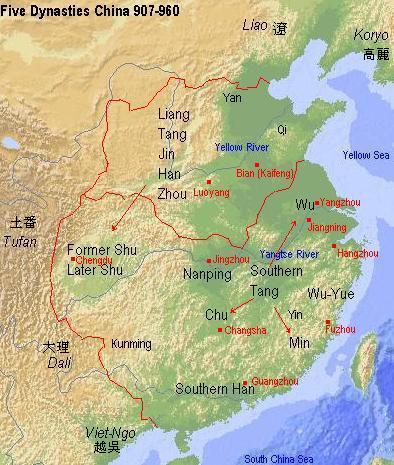
Keynotes 12
The Five Dynasties

The Rule of the Bureaucrats: The Chinese Song (960-1279) and Mongol Yuan Dynasties (1279-1368)
Northern Song (960-1126); capital: Kaifeng - Southern Song (1127-1279); capital Hangzhou
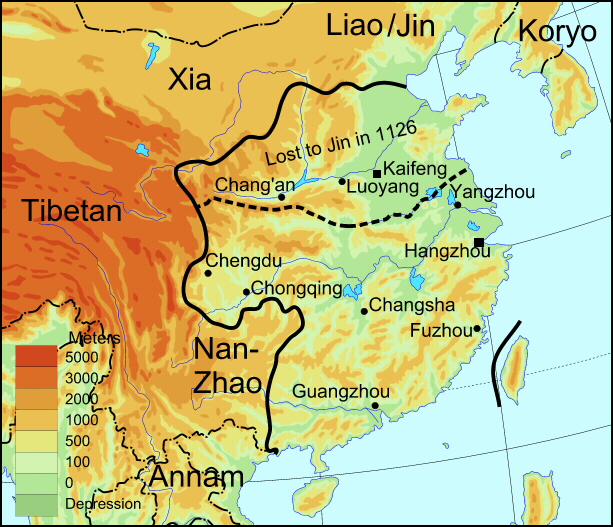
Northern and Southern Song
The most important state of the Five Dynasties, the Later Zhou (951-960) initiated the consolidation of power by starting economic reconstruction on a large scale: the most important steps were
• the repair of waterways, dykes locks, especially of the Grand Canal
• the cultivation of land that had been abandoned during the uprisings and warfare as soon as the An Lushan rebellion and following the end of the Tang.
The Later Zhou capital Kaifeng remained the center of government when the founder of the Song, Zhao Kuangyin came to power. During the Song Dynasty the government was restructured. The most important innovations were:
• Confucian scholars who had become civil officials controlled the military administration as well as expenses for the military;
• in order to prevent warlordism military leaders (many of them comrades in arms of Zhao Kuangyin) were pensioned;
• parts of troops were moved between different parts of the state to avoid concentration of power by military leaders
• state exams: the positions of power that had in previous dynasties been held by the aristocracy and the eunuchs were replaced by highly educated civil officials recruited through the
- prefectural
- provincial
- national exams;
- officials were regularly rated;
- promotions had to be recommended according to merits gained in civil service positions; the recommending official was responsible for his promotion candidate at any time;
- the officials were relocated every three years; there was an appointment quota according to location of origin
• commercial dominance:
- expansion of internal and overseas trade;
- beginning of a factory system;
- organization of merchants in guilds
• urbanization:
- growth of settlements;
- ward centered-system given up in favor of street-centered system;
- no nightly curfew;
- public bath houses;
- entertainment throughout the night in restaurants and teahouses, some with theater performances;
• dangers or urbanization: spread of fires; spread of disease;
• technological innovations:
- waterpowered mills and looms
- use of coal as fuel in steel production
- new explosives (seamines)
- movable type printing
• boom in publishing: government manuals for exam preparation; collections of old exams; manuals for officials (eg. on agricultural methods and tools)
Difficulties the Northern Song had to face:
• population increase (population doubled);
• more peasants worked smaller plots of land;
• peasants lost their independence to large landowners and had to work as tenants;
•defense expenses rose yet budget was drained by 'buying peace' from the neighbors with 'tribute gifts': Khitan (=Qidan; Liao), Xixia, Jurchen (=Jin)
The Liao (Qidan, Khitan) and Xi Xia (Hsi-hsia) states
Reforms of Wang Anshi (1021-1086)
Wang Anshi had developed a reform plan as early as 1056 but only had a chance to apply some of his ideas under the young emperor Shenzong (r. 1067-1085). Wang became chancellor twice: 1. from 1068 to 1076; 2. from 1078 to 1085
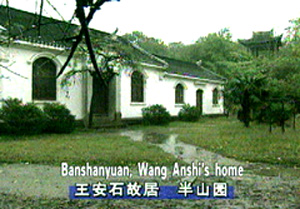
The reform was directed at changes in
prices, land tax, army, education
• prices: prices were controlled by the state; local products were bought by the state and sold with profit in different areas by government agents
• land: the land tax was lowered; lending money to small farmers at stabil loan rates for seeds; abandoned land was re-distributed; corvee service was partially transformed into money payments
• army: districts had to set up a trained militia equopped with horses (especially in the western and northern border regions)
• education: increase of government schools; state exam contents were changed: maths and administrative tasks became subjects
The reform was almost entirely abolished as soon as emperor Shenzong died in 1085. Wang Anshi as well as his strongest opponent, the conservative Confucian scholar and statesman Sima Guang (b. 1019) died in 1086.
The state deteriorated due to faction fights, tax losses, and draining of the state income due to luxurious adventures by the last emperor of the Northern Song, emperor Huizong. His Genyue-Pleasure Park in Kaifeng not only swallowed money and workforce, but instilled hate for the administration especially the 'Flower and Rock-Brigade' in the population.
When the Jurchen (Jin) and the Xixia attacked their neighbors, the Khitan (= Liao), the emperor formed an alliance with the Jin in the hope that China would regain the teritory that had been occupied by the Liao state. Soon the Jin turned against China, destroyed Kaifeng in 1126 and led emperor Huizong, his mother, the empress, and many court members into captivity. The rest of the court fled to the south and established a new capital in Hangzhou. The transition was dangerous and difficult as witnessed by Li Qingzhao (ca. 1094-1152; see below). The border between the Jin state and the Southern Song was established at the Huai River in 1142.
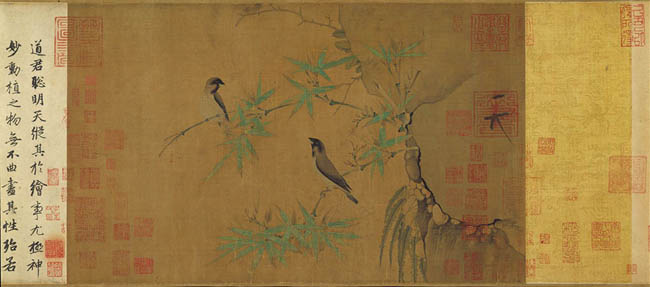
Finches by Emperor Huizong
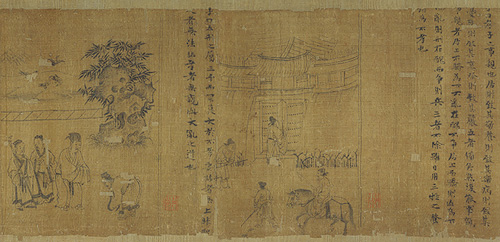
Li Gonglin, Szenes from the Classic of Filial Piety
The Southern Song
General Yue Fei fought against the Jin continuously. Due to opposition in the government and at court against this expensive and seemingly never ending war, he was imprisoned in 1142 and died in captivity.
• Commercial strength of the Southern Song:
- tax income through manufactured goods, monopolies (alcohol, salt, tea)
- seaports at the southern coast (Fuzhou, Quanzhou, Hangzhou) with settlements of foreign merchants;Chinese settlements in Southeast Asia: both brought high revenue through taxation on imported goods
- cultivation of cotton that replace hemp and ramie;
- paper and porcelain production on a large scale
• Technological innovation: woodblock printing using movable types with illustrations and maps; publishing boom served collectors, schools, academies, libraries
Neo - Confucianism:
- to revitalize Confucian ideas and develop a philosophical basis
that could not be challenged by Buddhism was the incentive by Song philosophers
such as the brothers Cheng Hao and Cheng Yi
- they attempted to enrich Confucian teachings with metaphysical
content by investigating phenomena and analyzing their li, (principle,
essence: of moral of physical nature) and qi (vital force or substance,
energy); the concept of the principles of li and qi made the
philosophy of Mencius ("man's nature is innately good") and its focus
on education better understandable: If someone has good principles (li)
but no perfected vital energy (qi) this person may be tempted to follow
selfish desires. Education and self-cultivation can improve this personal imbalance.
- the most important philospher of the Song was Zhu Xi (1130-1200)
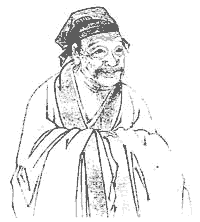
Zhu Xi
In his philosophical teachings he tried to improve the state from the bottom, from the family - the smallest unit within the community. He discussed with his disciples questions of self-cultivation: How to meditate and study; how to improve erudition by analyzing the Classics and entertaining literature; how to improve one's ethical insights etc.
After his death the emperor commissioned editions on Zhu Xi's commentaries of the Four Books: The Analects, Mencius, the Doctrine of the Mean, and the Great Learning. Every candidate for the examinations had to study these books and Zhu Xi's commentaries and as time went by this canon of writings became the basis of orthodox Confucian learning taught in China, Vietnam, Korea, and Japan.
Zhu Xi and other Neo-Confucian thinkers attempted to
revive Confucianism as the philosophical basis of education and state affairs
and integrate metaphysical aspects, which had not played a major role in Confucianism
so far, that they adapted from Buddhism and Daoism. The idea of uniting ‘Three
Teachings in One’ seemed to successfully bring the fruitful aspects of
all philosophies together while limiting the influence of the two religions
that had competed with Confucianism.
During the Southern Song the implementation of this Neo-Confucian ideology was
propagated from the family level and local communities up to the administration.
With printing technology improving the dissemination of knowledge propelled
the economic development of the Song and helped to attract more candidates even
from rather remote areas to participate in the state examinations.
At the same time the new technology also made the new and even more standardized
canon of moral teachings and philosophical considerations widely available –
from the local level, throughout China and to its Vietnamese, Korean, and Japanese
neighbors, who appreciated the rationality in the writings. The texts became
the basis for family education which concentrated on the sons as possible office-holders,
since in the meritocratic system an aristocratic family background or recommendations
from a high standing mentor were no longer required. The women were left out
of this development: The revitalized old ideal of the segregation of genders
confined them to the inner quarters of the household in China, Vietnam, Korea,
and Japan.
Women in the Song
Footbinding was the major drawback for women during this period; it became popular in the Song, but was practiced extensively during the consecutive dynasties.

Comparison between standard size women's shoe and shoe for bound foot
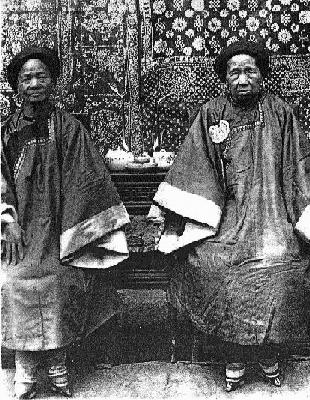
Women with bound feet
Li Qingzhao (ca. 1094-1152): the most famous poetess of the Song
Excerpts from an recollections in her unusual autobiography:
"I happen to have an excellent memory, and every evening after we finished eating, we would sit in the hall called 'Return Home' and make tea. Pointing to the heaps of books and histories, we would guess on which line of which page in which chapter of which book a certain passage could be found. Success in guessing determined who got to drink his or her tea first. Whenever I got it right, I would raise the teacup, laughing so hard that the tea would spill in my lap, and I would get up, not having been able to drink any of it at all. I would have been so glad to grow old in such a world."
Fate decided differently. After her husband died while travelling to an assignment during the Jin invasion, Li fled towards the south in order to join the families who had left Kaifeng trying to settle in the new capital, Hangzhou. She lost most of the invaluable books, calligraphies, paintings, rubbings, and antiques that the couple had collected over the years in their house in Kaifeng. They had compiled a catalogue of this collection which was saved. The autobiographical recollections are part of the preface written by Li Qingzhao in memory of her husband and the joyful time they had spent together in Kaifeng.
She reports from her odyssey: "We first gave up the bulky printed volumes, the albums of paintings, and the most cumbersome of the vessels. Thus we reduced the size of the collection several times, and still we had fifteen cartloads of books. When we reached Donghai, it took a string of boats to ferry them all across the Huai, and again across the Yangzi to Jiankang [= Nanjing]."
In the end almost all of these possessions were scattered, some stolen, some lost, some sold for money to travel on. What remains are her unmatched poems and her autobiographic essay in the catalogue of antiques of the couple's collection titled Records on Metal and Stone.
(Translations from Valerie Hansen, The Open Empire. A History of China to 1600. New York: W.W. Norton& Co. 2000, p. 276-277).
The Yuan Dynasty (1279-1368)
Chenghis Khan (1155-1227) had attacked the Jin and Xixia states since 1215. Beijing became the Mongol capital in 1264, long before the entire Song territory was finally taken over after decades of war.
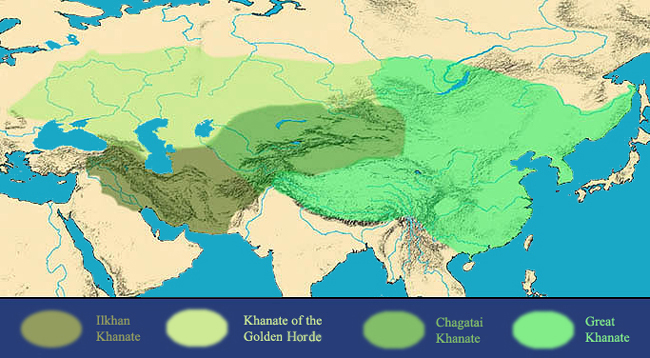
The Mongol Empire
• army equipment: helmet, bows & arrows, battle-axe, dried milk, dried meat, grain; protected horses
Mongol noble by Qian Xian
The Mongols ruled with the help of foreigners whose status in the administration was higher than that of the Chinese officials who could only serve on lower ranking posts. The military was entirely managed by Mongols.
• Strong points of the Mongol rule:
- the postal system was the fastest in the world;
- religious tolerance: Buddhists, Muslims, Jews, and Christians were equally tolerated.
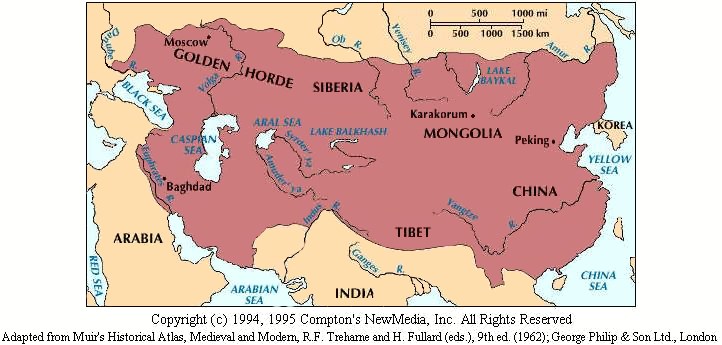 The
Mongol empire at its widest expansion
The
Mongol empire at its widest expansion
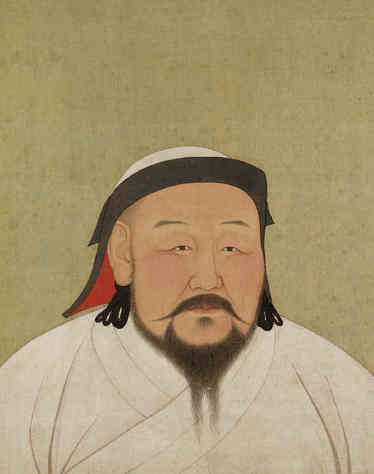
Khubilai Khan
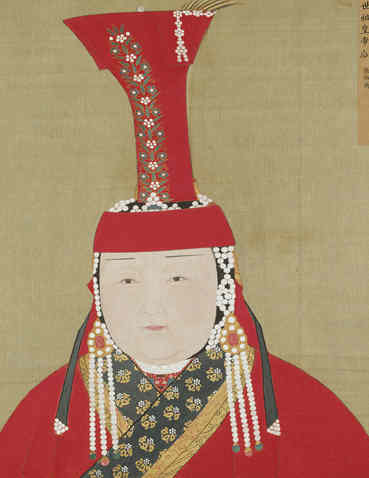
Chabi, the khan's wife
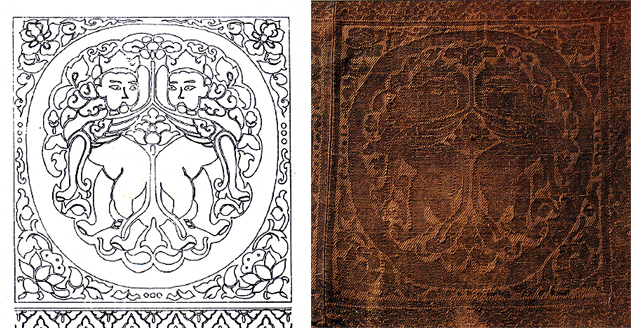
delicate silk weaving pattern
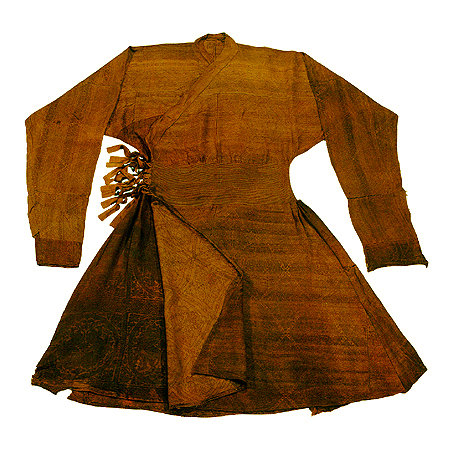
Mongol silk robe